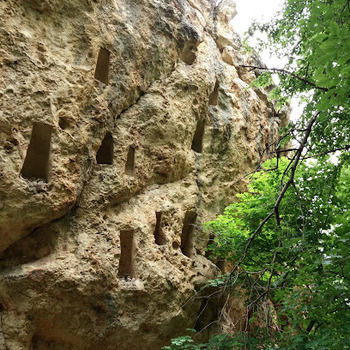Rock complex Kush Kaya Lyubimets city
Overview
Kush Kaya is a rock mass of inaccessible vertical stones, rising on a ridge at a height of 25-30 to 50 m. The bizarre shapes of the massif, located about 2 km northwest of the village, have received strange names. One of them is Babata. They attract the attention of everyone who travels from the area of Ivaylovgrad Dam to Lyubimets. In the village of Valche Pole it is known that there is a site on Kush Kaya, and in the last few years he has been the victim of raids by treasure hunters coming from different parts of the country. However, few know what exactly Kush Kaya is and that the place has been inhabited for many millennia.
After archeological excavations conducted in 2005, it was established that the place was inhabited during different epochs for long periods of time. These are the Late Bronze Age (16th-11th centuries BC), the Early Iron Age (10th-6th centuries BC), parts of the Late Iron Age (3rd-2nd centuries BC), parts of the period of Roman antiquity ( III-IVc), as well as from the period of the Middle Ages. The settlement of Kush Kaya was inhabited most intensively during the Late Bronze and Early Iron Ages. Two homes were drilled there.
A fortress wall has been registered, passing along the western edge of the ridge of Kush Kaya. Its construction can be attributed to the later phases of the Early Iron Age and certainly shows the importance that the site had at that time. Numerous fragments of well-made ceramic vessels, clay figurines with human or animal form, etc. can be listed among the finds.
Recommended
- Stone bridge - Biserska river
- Bakarlia Protected Area
- Castra-Rubra Fortress
- Mezek Fortress
- Mezek tomb
- The bridge of Mustafa Pasha and others


 Bulgarian
Bulgarian Romanian
Romanian
